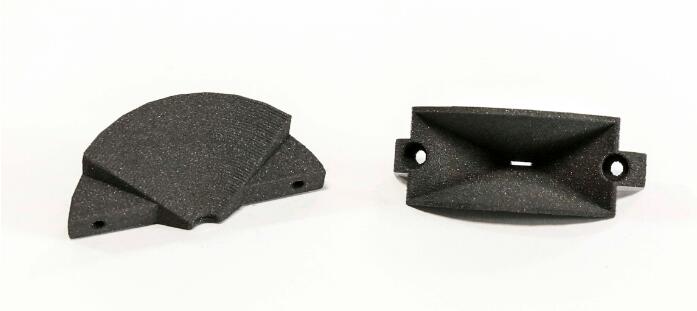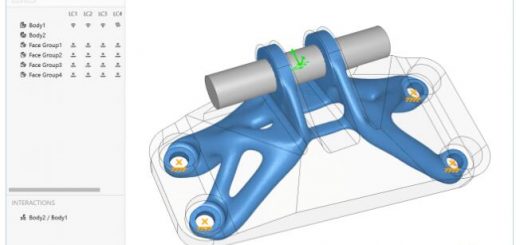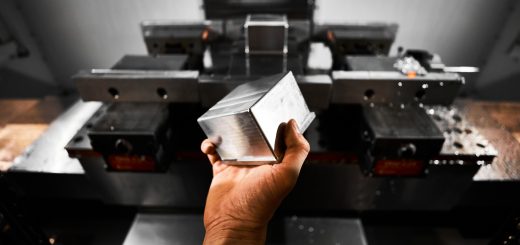ExOne Licenses ORNL Method to 3D Print Components for Refined Neutron Scattering
The Department of Energy’s Oak Ridge National Laboratory has licensed a novel method to 3D print components used in neutron instruments for scientific research to the ExOne Company, a leading maker of binder jet 3D printing technology.
A long-time collaborator with ORNL, ExOne will leverage the lab’s world-class expertise in additive manufacturing, materials and neutron science to further develop the patent-pending technique to 3D print collimators using a lightweight, metal-infused composite that is ideal for neutron scattering instruments.
 ORNL’s Bianca Haberl and Amy Elliott hold 3D-printed collimators — an invention that has been licensed to ExOne, a leading binder jet 3D printer company. Credit: Genevieve Martin/Oak Ridge National Laboratory, U.S. Dept. of Energy. Source: ORNL
ORNL’s Bianca Haberl and Amy Elliott hold 3D-printed collimators — an invention that has been licensed to ExOne, a leading binder jet 3D printer company. Credit: Genevieve Martin/Oak Ridge National Laboratory, U.S. Dept. of Energy. Source: ORNL
ExOne intends to scale up production of neutron-friendly collimators — the company’s first opportunity to offer high-quality, lower cost components for neutron beamline applications.
Similar to an aperture in a camera, collimators help to precisely define the neutron beam, a function that provides higher fidelity measurements of a sample’s atomic and molecular structure and dynamics.
“Our work on collimators has been focused on tungsten infiltrated with copper for use in X-ray machines, computed tomography, or CT, scans and magnetic resonance imaging machines, or MRIs,” said Dan Brunermer, ExOne technical fellow. “The technology we have licensed from ORNL will allow us to build collimators for neutron scattering, and that requires a specialized mix of materials and post processing.” Small, 3D-printed neutron collimators, designed by ORNL’s Jamie Molaison, yield reduced costs and manufacturing times and could enable new types of experiments. Credit: Genevieve Martin/Oak Ridge National Laboratory, U.S. Dept. of Energy. Source: ORNL
Small, 3D-printed neutron collimators, designed by ORNL’s Jamie Molaison, yield reduced costs and manufacturing times and could enable new types of experiments. Credit: Genevieve Martin/Oak Ridge National Laboratory, U.S. Dept. of Energy. Source: ORNL
Instead of tungsten and copper, ORNL’s method comprises a unique way of binder-jet printing a lightweight ceramic called boron carbide, or B4C, that is then infused with aluminum. The resulting material is called a B4C – Al metal matrix composite. The prototype collimators were formed using an ExOne binder jet machine at DOE’s Manufacturing Demonstration Facility at ORNL.
During binder jet printing, boron carbide, in powder form, was mixed with a liquid binding agent and layered into the collimator’s complex prototype design. The ORNL team then filled the part with either cyanoacrylate, an industrial adhesive, or aluminum. Compared to cyanoacrylate, the aluminum version adds structure and strength while reducing the presence of hydrocarbons, which can interfere with the flow of neutrons.
The prototypes were tested on neutron scattering instruments at ORNL’s Spallation Neutron Source and High Flux Isotope Reactor, both DOE User Facilities located at ORNL. The test parts performed well to guide neutrons into a narrow trajectory while absorbing wayward ones, yielding clearer, more precise scientific data.
“Machining a collimator through traditional manufacturing is quite challenging and costly,” said ORNL’s David Anderson, co-inventor and neutron scattering instrument engineer. “But they’re needed to reduce background neutron radiation at neutron scattering instruments. Most neutron scattering instruments, including those at SNS and HFIR, have them.”
Anderson led a team of inventors including Amy Elliott of ORNL, who specializes in binder jet printing, and ORNL neutron scattering scientist Bianca Haberl, an expert in using neutrons to study materials in extreme-pressure environments.
ExOne hopes to provide affordable collimator options for use on the hundreds of neutron beamlines operating around the world. And, with the opportunity for lower cost collimators made quickly, scientists could use a new, tailored collimator for each experiment.
“When they start to see experiment-specific collimators and how they have the potential to improve their test results, we hope to see the design, order and fabrication of these devices become the norm and not the exception,” Brunermer said.
ExOne expects to continue their relationship with ORNL. “Our collaboration continues to prove its value to the manufacturing industry with the outcome of projects like these,” said Brunermer. “It benefits ExOne, it benefits the customers of these collimators and it feeds money back to the American taxpayer.”
Co-inventors of the ORNL technology include David Anderson, Corson Cramer, Amy Elliott, Garrett E. Granroth, Bianca Haberl, James O. Kiggans Jr., Anibal J. Ramirez-Cuesta, Derek H. Siddel and Matthew B. Stone.
DOE’s Manufacturing Demonstration Facility at ORNL is supported by the Office of Energy Efficiency and Renewable Energy’s Advanced Manufacturing Office.
UT-Battelle manages ORNL for DOE’s Office of Science. The Office of Science is the single largest supporter of basic research in the physical sciences in the United States, and is working to address some of the most pressing challenges of our time.
Source: ORNL




Recent Comments